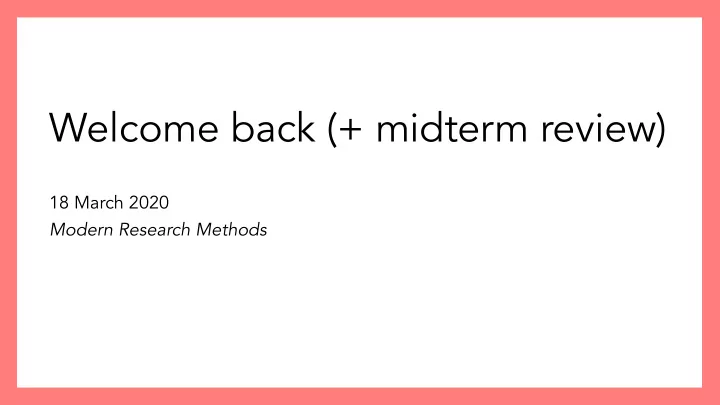

Welcome back (+ midterm review) 18 March 2020 Modern Research Methods
Logistics • As a reminder, this session will be audio/video recorded for educational use by other students in this course. • Getting to the classroom (links in Canvas and on website) • Office hours – same time, but over Zoom • Must si sign-up up using spreadsheet • If you’re unable to make those times, let us know and we will do our best to accommodate you
Zoom etiquette • Mute yourself when you’re not actively speaking • Unmute to speak • Then, mute again after you speak (or hold spacebar to unmute) • Use headphones if possible • Prevents feedback from your speakers • When you want to speak, raise your hand • When I see your hand raised, I’ll call on you
Midterm • Grades are posted • Spell check! • Still some formatting issues • 5pts on the midterm for appropriately formatted responses • If you got penalized for this, there should be a note in canvas • You may fix your midterm and turn it back into us to get this points back (by next Wednesday) • Formatting issues: • Printing out whole dataset • Not using any headers • Writing responses as comments in R code
What does the rest of the semester look like? • Today, go over midterm • On Friday, more practice with effect sizes • Then, we’re going to start working on the final project – a meta-analysis • We’ll talk more about this next week, but start thinking about what psychology questions you might be interested in studying
• New scientific knowledge is built upon on the findings in previous research and each other’s research • Involves reproducibility; tools like R markdown and Github facilitate this • Involves replicability; p-hacking and other QRPs slow cumulative science
What makes a good measurement? Re Relia liabilit bility – Consistency of measurement (Do you say the same thing today as yesterday?) Va Validity – Are we measuring the construct we want to measure? Suppose the thing we’re trying to measure is the center of the bullseye…
P-value: binary statement about whether there’s effect [significant/not significant] • note: p-value doesn’t tell you about the size of the effect since the p-value depends • on the confidence interval Confidence interval: Range of plausible values for the mean • Effect size (e.g. Cohen’s d): magnitude of the difference between the two means •
Co Confidence intervals: • Set of plausible values for an estimate • If you run an experiment 100 times, the true population value will be included in 95 of the confidence intervals
What are violin plots? • Same as probability density (geom_density()), except mirrored/doubled and turned on its side • Often preferable to bar graphs because it allows you to see the distribution of the underlying data • Another alternative “rain cloud” plots
On Friday • (will post solutions to midterm online) • More practice with effect sizes • Reading:
Recommend
More recommend